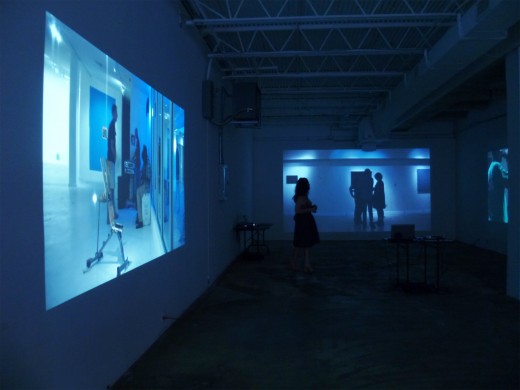
NATALIA ZULUAGA (RAIL): Why don’t we start at the beginning? Tell me how the idea of The Nightclub was born, and what were its aspirations?
THE NIGHTCLUB (NIGHTCLUB): The idea came from a very selfish position to empower artists in a remarkable literal sense, by inviting them to take a day to curate an exhibition. The opportunity would allow artists to perform and create projects they could not do in another architectural space. Each month, a curator would work independently without [our] interference or expectation. Only the duration, and the time and day of the month would remain constant. The intention was to be a tool to critique the ideas involved with exhibition-making, including the production of art, while at the same time supporting and guiding in a minimal way the ideas of the curator.
The Nightclub came at a moment of mutual availability and an openness to the idea of activating things. We both normally act as networks, and this opportunity flourished in a time of extended interchange of documentation and motivating ideas.
RAIL: By creating the basic structure that events would be held for one night for four hours, you critically transformed the limitation of available space into a curatorial premise. How did this happen and what became the importance of the four hours?
NIGHTCLUB: It evolved as a practical solution to an imminent problem. The original place we had conceived as a venue had restrictions in terms of the time we could use it. So, just as things tend to happen, we adjusted to a short time format that soon after we re-edited and included as part of the model of The Nightclub.
Time and location had to be taken into consideration. We figured the show could be anywhere—in other places, in the other place. The structure of nomadic and ephemeral exhibitions was an option rather than a limiting factor. The project’s development was subject to a conceptual framing that comes down to an interactive procedure with uncertain outcomes.
The duration of time is an important factor. Mental work that is focused in four-hour duration spans, the four hours that are endured in a situation of a nightclub. This is not an exhibition opening in the traditional sense. You see it or you don’t. The hours are an element of performance—the ephemeral and the transitory. It is an exercise of discipline to turn the lights and the projectors off or on. We could be having a good time, we could want more. There is always the intention among the actors to prolong it, to stay. “Why end it?” In the end the “Nightclub” sign moves to another location where it will sit silently on a window ledge, the blue neon light is no more.
RAIL: Did you ever find yourselves tempted—for lack of a better term—to anchor down? I mention this because, during the week of Art Basel Miami Beach, The Nightclub ran for a longer period of time, and over multiple days. What were the intentions behind the idea of breaking the structure then?
NIGHTCLUB: The extension over two weeks was purely circumstantial. We had originally proposed and invited previous collaborators to do an exhibition including works, documents and contributions from previous Nightclubs titled Thank You For Coming. But that week was too crazy for everyone to contribute something meaningful. In the end, the limitations on space dictated this shift from the original model. Instead, we held two Nightclubs over the course of two weeks during which the space needed to remain open.
RAIL: What were your expectations when you set out to establish a platform for alternate forms of exhibition-making? And after 10 Nightclubs, what have been the challenges and the lessons of attempting to incite critical exchange here in Miami?

Installation view of During Four Hours organized by José Antonio Navarrete and Marcos Valella. Photo courtesy of The Nightclub
The Nightclub proposes a model of operation and connectivity in Miami. It is a sample of an organization, a sample of ephemeral production, a field of research, and a case study of each edition. The challenge has been to fit both personal needs and the intentions of your collaborators into one space, while trying to build a collaborative and dynamic space. We’ve tried many possible solutions in the face of all kinds of issues related to production management, personal relationships, ideologies, leadership, conceptual bases, communication, among others. Critical exchange happens in every edition, at least between the people involved in each venue. It has been happening in varying intensities and reaching out to different audiences at the time. If this permeated from the individual into the public realm, then we consider it a huge success. In many ways it shows the complexity of the art scene in Miami. It was a good way to challenge traditional terms of display and inflexible institutional structures, and to try new systems of making knowledge.
RAIL: The clock will soon strike midnight as The Nightclub nears the end with its 12th edition. What happens after you turn on the lights? And further, do you have plans to create a document, or archive of this experience?
NIGHTCLUB: We have talked about the possibility of a publication that would summarize the entire programming of The Nightclub, but a date of publication is still undecided. There are still two Night Talks planned for the next two months. And at the very end we plan on closing with an event called “Let’s Dance” with the participation of artists as D.J.’s—the fun part.










